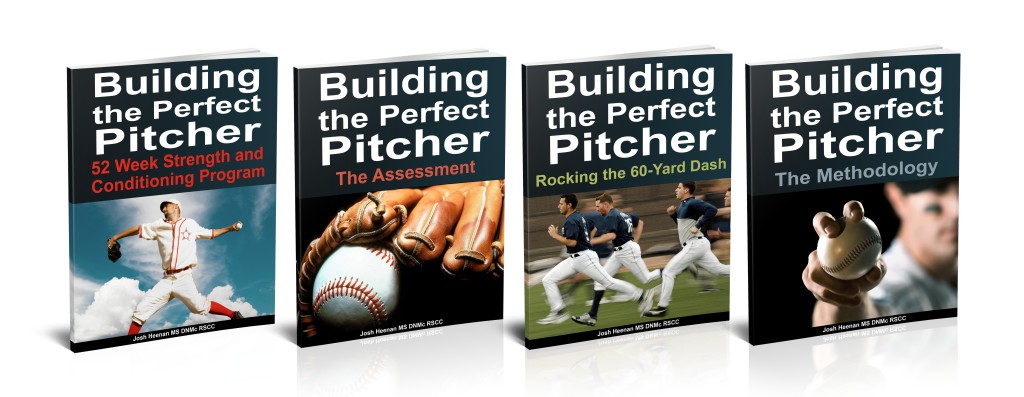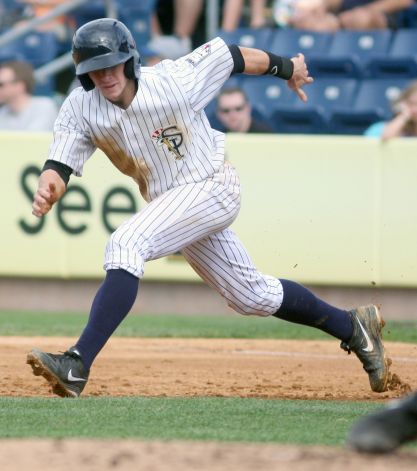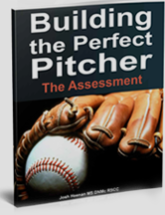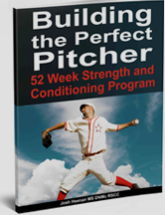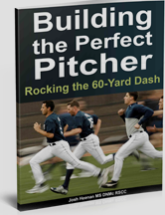12-Week Weight Gain Coaching For Baseball Players
12-weeks ago a group of readers started my private distance weight gain program. After an initial evaluation, movement screen, and goal setting we proceeded with both a training and nutritional plan for each athlete.
The groups average results were:
-20lbs of bodyweight gained
-100+ lbs added to their front squat
-125+ lbs added to their deadlift
-10+ reps added to their chin-ups
I couldn’t be more proud of these athletes (and families!) for making the short term sacrifice of eating a large amount of food and truly dedicating themselves to hard training.
Although we do have one problem
I promised the person with the most dramatic transformation to receive a full refund for their hard work. After much deliberation with my colleagues, we have not been able to determine a winner, so I am enlisting you, my readers to help choose a winner.
Please Vote Below– Voting Ends Friday February 5th at Midnight!
Brad
Today I weight 221, a total weight gain of 23lbs. I have been consistent with weight training throughout the entire 12 weeks. I was able to do a dead lift of 255 as of the end of my weight training. Before I started this training, the most I was attempting was 135. When I started I was doing about 4 or 5 chin ups, now I can do 12. Since baseball practice started I have gone out and am only throwing about 70% effort and my coach noticed I’m throwing harder than last year. When I was pitching I was able to get 8 batters out in 25 pitches at practice. The most important thing is that a college coach I’m talking to noticed the big change in my size since I went to their training camp in the summer and they asked me to throw a “tryout” bullpen at the college next week. Each week I followed your advice and I never had a hard time reaching the weight goals; I was usually ahead of schedule. My goal was to get to 220 and I reached that with 2 weeks to go to the end of the weight program.

Garrett
First off, thanks for making my money well spent whether or not Garrett wins the contest. I can tell a difference as well as many friends and family.
Though he didn’t meet the full expectations; we offer the following results:
Total weight gain – 139lb to 159lb
Squats – 135lb to 200lb
Chin-ups – 6 to 25
Pushups – 30 to 70
Dumbbell incline press – 30 lb to 60lb
these are all his working weights, not max outs. – Garrett’s Father
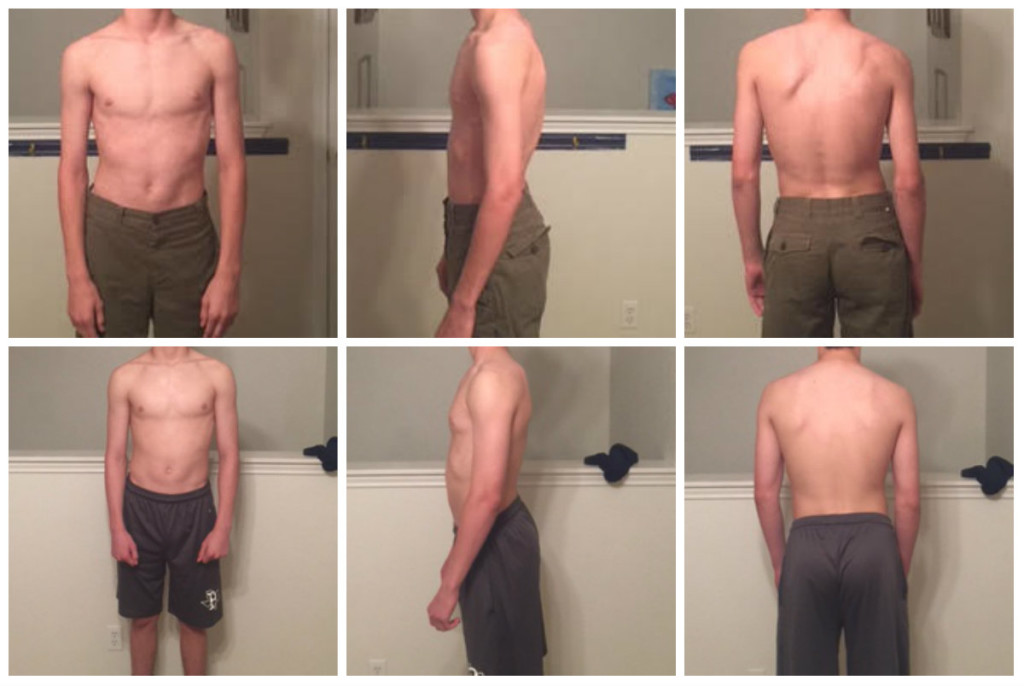
Keanu
My current weight is 171.8 after starting off on an even 148. Being up almost 24 lbs seems huge for 12-weeks worth of work. Strength wise I’ve been noticing major increases in each and every workout, but I haven’t been keeping track of how much exactly except in certain workouts like my rows being up 30 lbs and my deadlift going up 150+ lbs with a max that’s just shy of 200 lbs more than when I first started the program.
This whole experience has been very critical to me in not only playing baseball going forward, but in life because I always wanted to become a bigger person and weighing 150 on a good day wasn’t going to get me anywhere I wanted to go. I wish I could be gained more in this 3 month span, but I’ve learned a lot about how much I need to eat, on top of taking protein and creatine consistently. This definitely won’t be the end of my quest to gain muscle mass and I will without a doubt take what I have learned and incorporate it into my everyday life to become a stronger and better baseball player. Thank you for this opportunity, Josh.
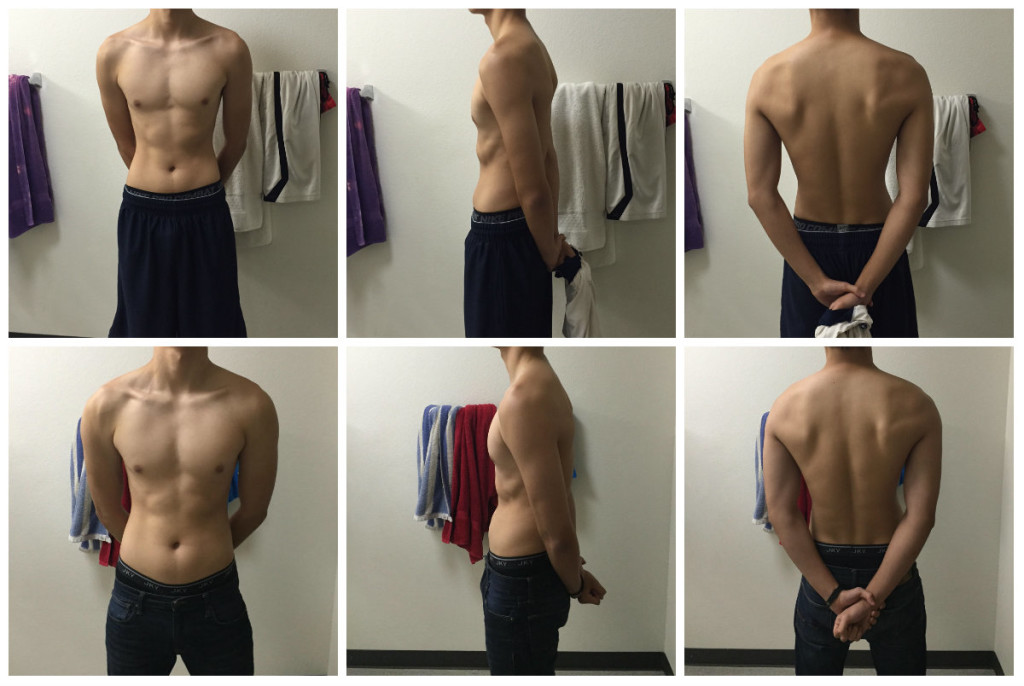
What Does A 100MPH Fastball Look Like In The Gym?
Throwing 100MPH is the goal of many baseball players, pitchers and position players alike. 100 MPH is a tremendous goal, but to be realistic, on average less than 10 MLB pitchers touch 100MPH per season. There is a reason why guys like Aroldis Chapman make 8 million a year.
So how do you create the ability to throw that hard?
Great arm mechanics? YEP
Shoulder-hip separation? YEP
Adequate stride length? YEP
There is no substitute for great arm mechanics and throwing with maximum intent, but many throwers have pretty good arm mechanics and throw with intent. The biggest difference I see with our extremely hard throwers (95+MPH) is they are BIGGER AND STRONGER than those who throw with less velocity.
A great example of this is one of our guys in the Brewers Organization, Alex Farina. Alex touched 95 with regularity in his first season of pro ball.
Returning from the season Alex was a solid 215lbs. Not bad for a 6-foot tall athlete, but we knew he had some growing to do and some strength to gain.
Fast forward 5 months
Alex has busted his butt both in the weight room and kitchen. As of February 1st, he will be a solid 240 lbs. That’s a solid 25lbs to his frame in less than 5 months. What’s just as impressive (AND IMPORTANT!) is that his strength gains have matched every new pound of bodyweight. Sure, he can now deadlift over 600lbs and perform strict chin-ups with 75lbs of external load… for reps… BUT the real impressive feat of strength and power for Alex is his reverse lunge. See below
Many professional athletes wish to posses a 335lb back squat, their dream back squat is what Alex puts on his back and lunges… for reps.
Technique and position are incredibly important to our programming as this prevents injuries and allows us to transfer strength gains to the on-field needs of the athlete.
Think the lunge position matters to throw hard?

WE DO!
So what is your next step today to throw harder?
Check out our on-site and remote programming services at http://www.advancedtherapyperformance.com/
5 Reasons Why You Can’t Gain Weight
Having coached hundreds both in person and as distance clients that routinely put on 20-30lbs in their first 12 weeks of training. I can vouch that many are dedicated to reaching their goals but often have 1-2 major faults that inhibit them from putting on the weight they desire.
Here are my top 5 reasons why people are unsuccessful in gaining weight
5- You are not training with intensity
It’s beyond the scope of this article to dictate if you are on the correct training program or not to gain weight, but regardless of the program, you need to be training with intensity.
Intense training will create the physiological effects that will signal your body to increase muscle mass. Just as important, a solid training program executed with intensity will help increase appetite and allow you to consume more calories over time.
Don’t go through the motions, Train your butt off.
4- You don’t prioritize sleep
Sleep is the time to recover and grow.
Many athletes stay up watching TV and playing video games until 2-4am. Leaving them only 4-6 hours to sleep. When you are able to get deep sleep, your body produces a hormone profile that is optimal for increasing muscle mass and dropping body fat.
For more tips on sleep check out my T-nation article 4 Sleep Strategies for Athletes’
3- You don’t meal prep
This one drives me absolutely nuts.
Without preparing your food in advance you are going to find it near impossible to get enough food in throughout the day. Unless you are a professional athlete, you have to contend with class and/or work on top of everyday life. Having a bunch of meals prepared and snacks always by your side is the easiest way to reach your goals.
I’ve had high school athletes hide PB&J in their backpacks and sneak them in during class or in between class.
I’ve had professional athletes prepare 10-20 meals prior to a long road trip where they know the only options will be McDonald’s for for dinner just about every night.
It doesn’t matter how you get it done, you need to consume enough nutrients for your body to grow. Make it easy on yourself and pack your meals.
2- You have the wrong mindset
Being a skinny kid gaining weight is uncomfortable. It requires preparation, extra time cooking, extra time cleaning, extra time eating, and food will get boring.
GET OVER IT
If it was easy EVERYONE would be their ideal bodyweight, throw 95MPH, and drop 500 foot bombs.
Having a task oriented mindset and understanding that being uncomfortable is a part of the process.

1- You do not have big enough consequences and a support team
I’m a big fan of S.M.A.R.T. goals.
Specific
Measurable
Achievable
Results-focused
Time-bound
Every weight gain athlete I’ve ever had in person or distance coached has implemented S.M.A.R.T. goals with weekly check-ins. These small weekly goals along with surrounding yourself with a team who has the experience and knowledge of how to add some serious weight in a short amount of time makes a world of difference. In our Southport facility, some of the best coaches we have are athletes who have previously gained 30-40 lbs in previous years talking to other athletes.
In regards to consequences, rarely does anyone ever fails to reach their goal when the stakes are high enough. In house, athletes often pick the punishment of eating a can of dog food if they miss a weekly goal. No wonder why no one misses goals.
Move Fast, Throw Hard, Live Well – Development is a process, not a destination.
With the draft only a few days away, this list will bode well for many of my clients and readers hoping to one day be drafted.
88 percent of NFL draft picks played multiple sports
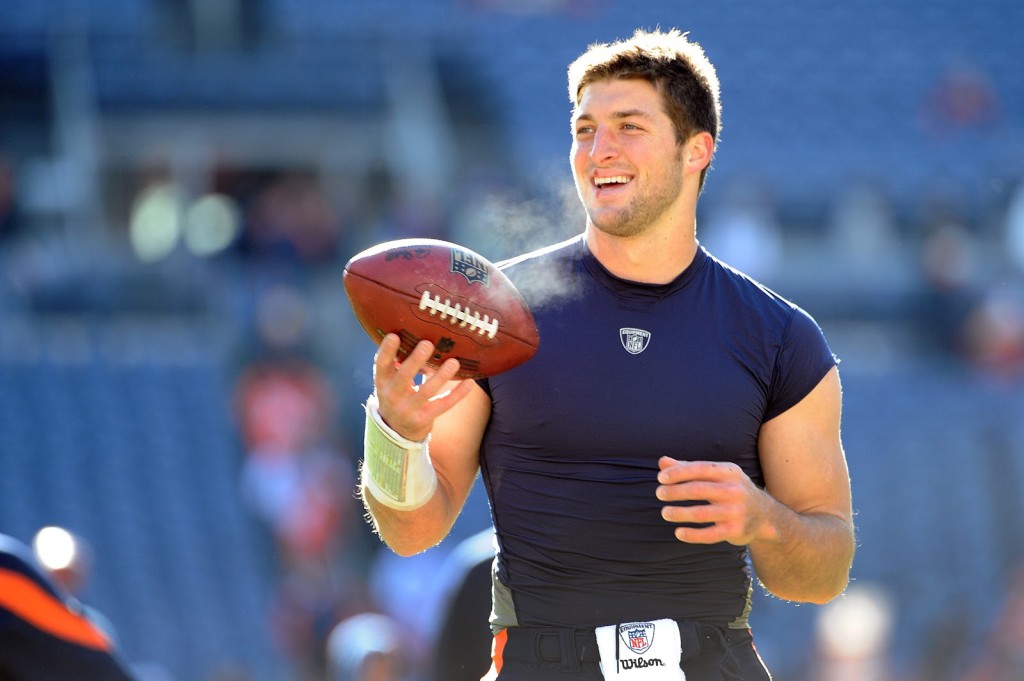
“According to TrackingFootball.com, 224 of the 256 players chosen during the draft were multi-sport athletes in high school. Of all draftees, 63% participated in track and field, 48% played basketball and 10% played baseball.”
Research has been pointing athletes towards playing multiple sports for maximum athleticism and decreased risk of overuse injury for years now. In my collegiate and clinical coaching experience, anecdotal evidence has been overwhelming that multi-sport athletes are healthier and reach high levels than their specialized counterparts.
Cubs manager Joe Maddon speaks out against specialization
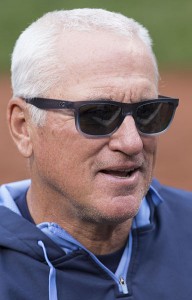
“I hate the specialization with kids, when they’re playing on these travel squads when they’re like 12, 13, 14 years old, only dedicated to one thing, Traveling all the time. Paying exorbitant amounts of money to play baseball with hopes they’re going to become a professional baseball player. “I think that’s crazy. I love cross-pollination when it comes to athletes, You get guys that did not just play baseball, meaning they’ve been around a different set of coaches and styles and ways to get in shape and thoughts. I love that.” Maddon said
Many parents I speak to are terrified that their child will not be prepared to play a high level of high school sport, will not get a scholarship, and will not get drafted. I understand the worry, but many are racing the wrong race. The goal should be to maximize enjoyment of the game, become as athletic as one can become, and keep on developing. Development is a process, not a destination.
3 Eating Secrets to Bulk Up Fast

This week I have been bombarded with muscle gain and weight gain questions. With the summer approaching, many athletes are looking to pack on weight while playing and training hard. This can be tough, but is done every year in our gym— usually 20-30lbs in a 3-month window. These three tips help many of our ball players stay on track during these bulking phases.
Qualities Needed to Throw 90+MPH
If I am a 17-year-old, 165 lb pitcher, and can consistently throw 79-82 MPH for my fastball, if I get up to 200 lb with 12% or less body fat, should I be able to throw in mid 90s or at least the 90s?
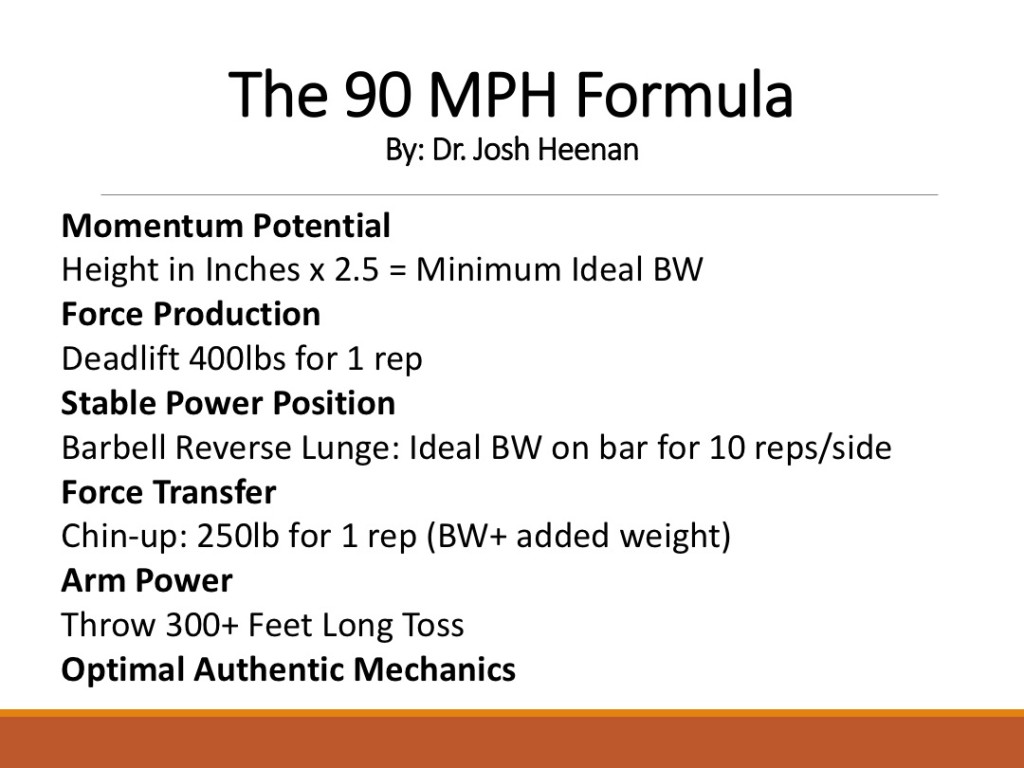
Bodyweight has been directly correlated to fastball velocity.
Relationships between ball velocity and throwing mechanics in collegiate baseball pitchers
I touch upon this point here: “As a general rule of thumb, our Sacred Heart pitchers will gain 2-4 mph a season during their 4 years in college. As much as I would love to say it’s just training, there are numerous reasons why we get increased ball velocity each year including mechanical improvement, growth of body due to puberty, increased muscle mass, and improved body awareness/muscular coordination. The interesting trend is that most of our athletes tend to add anywhere from 5-15 lbs of bodyweight each year. Does 5-15lbs = 2-4mph on the mound? Maybe.”
Why All Baseball Players Should Be Using Creatine
With my pitchers, we have the following hierarchy/system:
1) Mechanics Rule All: Increase mechanical efficiency your energy leaks will decrease and velocity will go up.
2) Increase General Strength: Building a foundational base strength is not only performance enhancing, but done properly will decrease the risk of injury.
3) Increase Muscle Mass: More muscle mass, the more potential to apply force.
4) Increase General Force Production (e.g. Power): Allows us to tap into more high threshold motor-units to produce more force and increase IIx muscle fiber.
5) Increase Skill Specific Power: Explosive training in a transverse plane. This could be med ball throws, weighted or under-weighted ball throws, long toss, flat ground or even mound work.
We have had many mid 90MPH pitchers (injury free to boot) as well as some whom have touched 99+MPH. Some of these athletes have gained upwards of 50lbs of very clean weight (still viable abs) in less than a year. Everyone is different based on genetics, work ethic, movement capabilities, diet etc.
If you are mechanically efficient, have relatively long levers and can increase body mass to 200lbs and force production increase proportionally it is very possible. This information as well as programming for this goal is covered in detail in Building the Perfect Pitcher.
Portraits: NY Yankees John Murphy
The All In Productions crew produced a great feature on one of our athletes, John Murphy. Take a moment and see what makes this athlete motivated to make the show.
The 60-Yard Dash: A Case Study
The 60-yard dash is often one of the first quantitative tests scouts at both the college and professional levels wish to see performed well.
This test has been deeply engrained into the dogma of baseball, while science and many coaches believe that there are better options. The 60-yard dash tests acceleration, top speed, and maintenance of top speed over 180 total feet. In general, baseball is a sport of acceleration and deceleration, not top speed. Regardless of it’s applicability many coaches and scouts use it as a gauge of athleticism and should at least be a consideration for athletes wanting to been seen as competitive. Here’s a case study to show how we address improving speed.
As an incoming freshman shortstop at Sacred Heart University, John Murphy had a 7-7.1 60-yard dash. With a front squat max of 245 and a vertical jump of 25 inches his power and strength was considered average to below average for SHU’s program.
My favorite test for both power and asymmetries is the single leg triple jump (SLTJ). The test is performed by standing on one leg and making 3 consecutive broad jumps on the same side while remaining in control. The goal is to jump as far away from the starting point while sticking each landing. When there is a side-to-side discrepancy of over a foot I investigate deeper to see if we are dealing with strength deficit or something more structurally.
Scoring an average of 21 feet on each side puts John right in the middle of a team average of 22, nothing special to say the least. The ability to apply force into the ground and accelerate your body forward gives us a nice picture of single leg power and a large carryover to running.
As you can see in the chart, as the years progressed, John’s squat, single leg triple jump, vertical jump, and front squat to bodyweight ratio make improvements every year. Increasing relative strength compared to bodyweight and teaching how to increase force production once movement dysfunctions are addressed will consistently increase speed— more importantly acceleration.
An interesting fact to note when looking at the data is that John’s junior year is when he really took his diet to the next level. When dealing with athletes of all levels it clicks at different times. Sometimes this has to do with whom they spend the majority of their time with and sometimes it just takes time to see the light at the end of the tunnel with a goal. Either way, John honed in on his diet by adding about 10 lbs of muscle and dropping a few of fat, again increasing his potential to produce force and become faster.
By John’s senior campaign he had been clocked as low as 6.5 in his 60 and was easily the most powerful athlete in his program. Looking back at his freshman year 21 foot triple jump (7 feet per jump) and increasing it to 26 feet (~8 ½ feet per jump) is a very large difference. This effectively lengthens his stride without changing his mechanics and drops 3-5 strides or ground contacts during his 60-yard dash, dramatically decreasing his time to plus speed in the eyes of MLB organizations.
When training athletes, strength coaches often forget the goal of athletic performance. Our job in the weight room is to help minimize or prevent injury, increase movement efficiency, increase overall strength, and increase force production in a way that it relates to our athlete’s events. You can see we did not test vertical jumps in 2012 because after the past 6 years I have come to realize that the carry over to baseball or other athletic development is much larger with the triple jump gave me lots of qualitative and quantitative data to use in our programming compared to vertical jump data.
Tips to Increase Acceleration Speed
-Video tape and practice your 10-yard dash. Use the video to get your current time and work to improve it. Once your 10-yard dash goes down, your 60 will drop dramatically.
-Increase your front squat max to 1.7-2x bodyweight with solid depth.
-Minimize fat mass and optimize muscle mass. Murph has had his bodyfat as low as 4.5%. By carrying minimal fat mass all weight is functionally producing force.
Mastering the Perfect Baseball Off-Season, Part 2: Nutrition and Psychology

For our players—or any athlete—to make physical gains, they must also have a healthy diet and a strong mindset. So Sacred Heart’s off-season program strives to build both. Although we don’t like to brag, the results have been impressive: our team won back-to-back Northeast Conference Championships in 2011 and 2012, and one of our players used our program to pack on 15 pounds of lean muscle mass while decreasing his body fat.
Here’s how he did it—and how you can do it too. Stack.com
Mastering the Perfect Baseball Off-Season, Part 1: The Program
Sacred Heart University’s off-season baseball program has yielded tremendous results, dramatically improving team performance on the field. Our methods are based on individualization for each athlete to optimize injury prevention, force production, nutrition and psychology… Continue Reading
Why All Baseball Players Should Be Using Creatine
Creatine is a compound found primarily in muscle cells in the body and in food, especially red meat. Baring any liver or kidney dysfunctions, creatine has been show to be safe to use for adolescences and adults. In fact, there is some research that shows lower levels of LDL and triglyceride for users of the product.1

In numerous studies, the use of creatine has been show to increase lean body mass, decrease short sprint times (power), increase vertical jump (power), and an increase in creatine levels in skeletal muscle.2 During activities with short bursts (~10 seconds) of work, our body utilizes creatine as a source of fuel, giving us more energy readily available.
Pitchers specifically have even more reason to be using this supplement year round. Bodyweight has been directly correlated to fastball velocity, and creatine has been shown to increase bodyweight through both muscle mass and water retention.3 The increased bodyweight allows pitchers to put more force into the ground and transfer more force into the ball.
As a general rule of thumb, our Sacred Heart pitchers will gain 2-4 mph a season during their 4 years in college. As much as I would love to say it’s just training, there are numerous reasons why we get increased ball velocity each year including mechanical improvement, growth of body due to puberty, increased muscle mass, and improved body awareness/muscular coordination. The interesting trend is that most of our athletes tend to add anywhere from 5-15 lbs of bodyweight each year.
_thumb.jpg?max_width=450)
Does 5-15lbs = 2-4mph on the mound? Maybe.
My recommendations for creatine are based on the most studied form— creatine monohydrate. Other forms may be fine, but they have limited research backing them and are outrageously priced. Take 5-10 grams a day ideally post workout with a protein and carbohydrate shake. There is little need to use loading protocols to “saturate” the muscles. Just be consistent with your use.
This post is geared towards baseball players, but in reality, if you are an athlete or have athletes that are looking to move faster, jump higher, and have more energy; this is probably a supplement you would be wise to investigate for yourself.
Feel free to post questions below.
Citations
1. Juhn MS, Tarnopolsky M. Potential side effects of oral creatine supplementation: a critical review. Clinical Journal of Sport Medicine. 1998;8(4):298–304.
2. Ostojic SM, others. Creatine supplementation in young soccer players. International journal of sport nutrition and exercise metabolism. 2004;14(1):95.
3. Werner SL, Suri M, Guido JA Jr, Meister K, Jones DG. Relationships between ball velocity and throwing mechanics in collegiate baseball pitchers. J Shoulder Elbow Surg. 2008;17(6):905–908.




